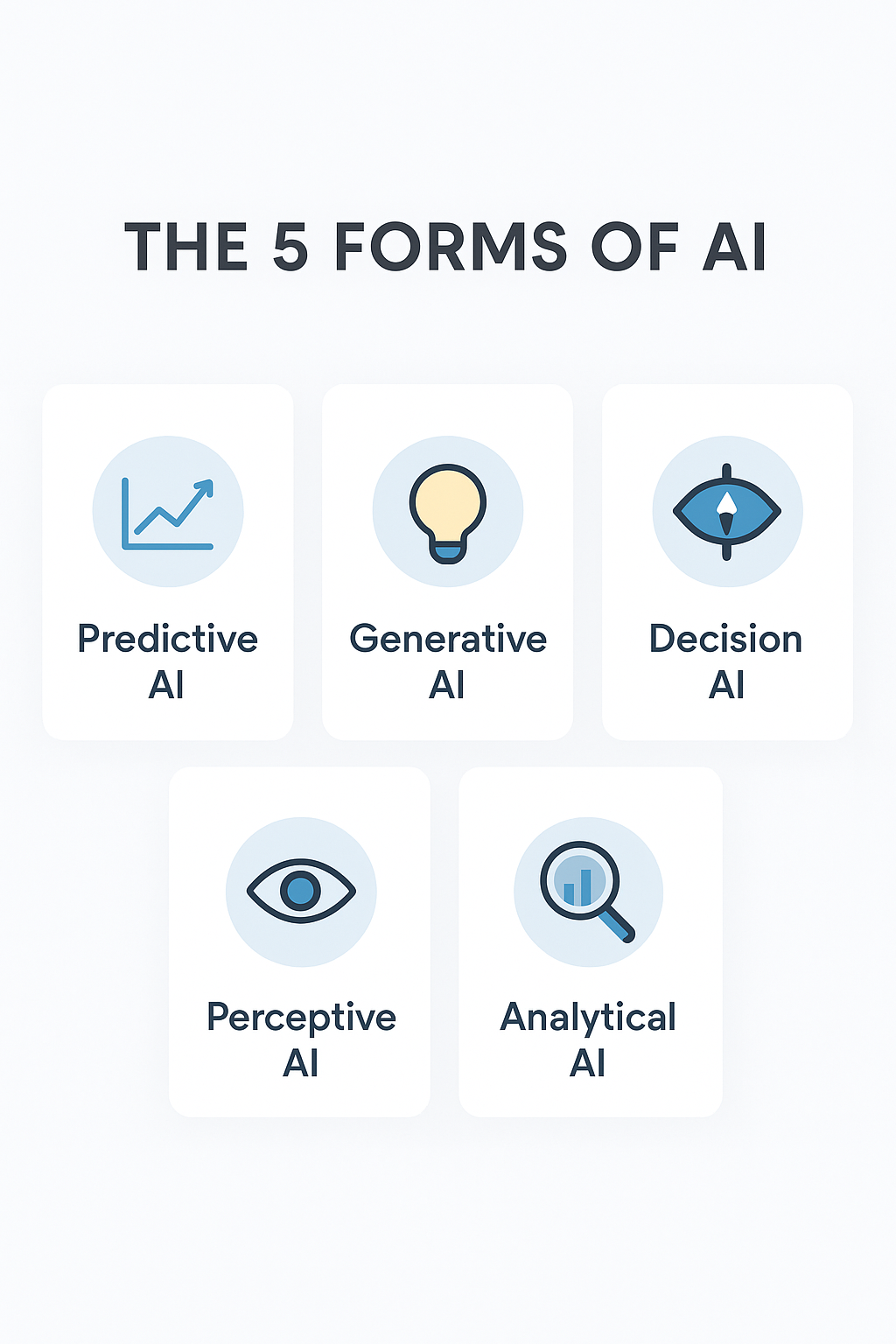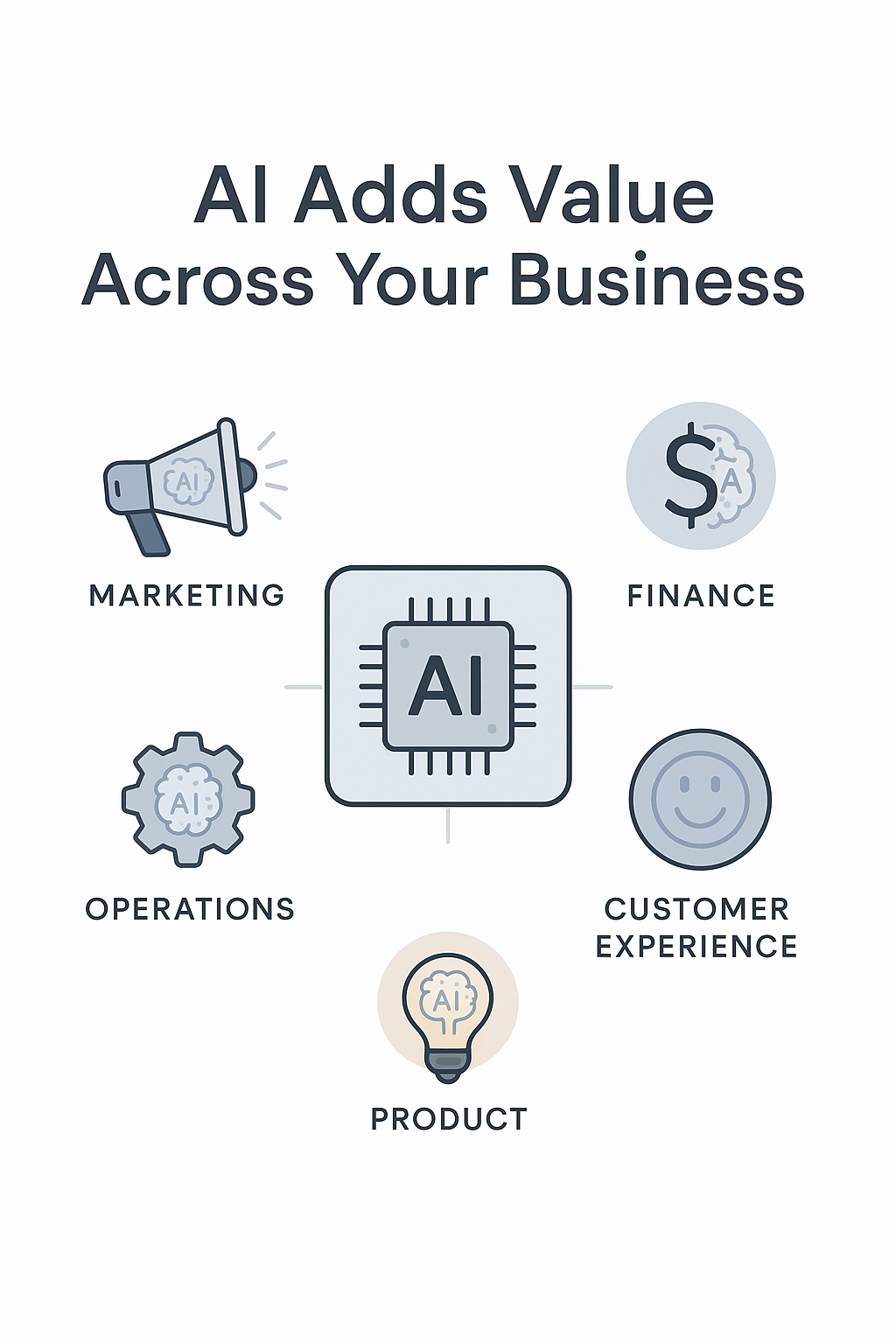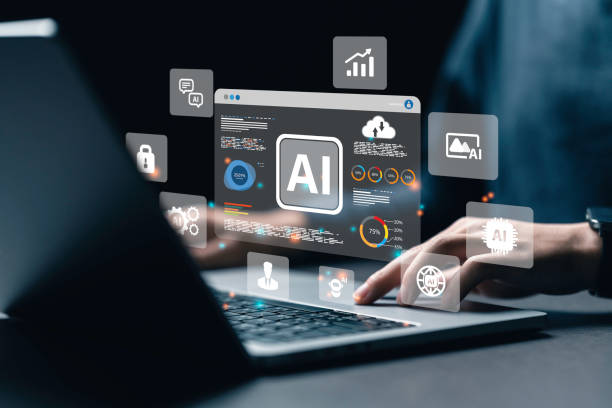In the modern business world, AI is often treated as a buzzword. From boardrooms to breakrooms, you hear terms like “machine learning,” “deep learning,” and “generative AI” tossed around. But what do they actually mean for your business?
AI adoption has rapidly accelerated. It’s no longer just about experimentation, it’s about execution and scale. Today, even small and mid-sized companies are integrating AI to optimize operations, enhance customer experiences, and drive growth. Industries embracing AI see revenue per employee grow 3x faster. But here’s the reality: AI isn’t one-size-fits-all. It’s a set of tools and techniques, each with distinct strengths.
To make sense of it, we’ve classified AI into five key forms, recognizing there’s overlap but aiming to provide clarity. These forms help us understand what AI can do, when to use it, and where it might add value to your organization with some real company examples.

1. Predictive AI
What It Is
Predictive AI helps organizations anticipate future outcomes based on past data. It identifies patterns in historical data and uses them to predict or forecast what’s likely to happen next enabling businesses to make proactive decisions.
When to Use It
- To forecast events like sales, customer behavior, or demand.
- To anticipate risks and opportunities before they happen.
Common Types
- Forecasting: Predicts future trends, like sales or weather.
- Machine Learning: Finds patterns in data to predict what might happen next (e.g., which customers are likely to leave).
Applications
- Retailers forecasting inventory needs for the holiday season.
- Banks assessing credit risk for loan applicants.
- Marketing teams predicting likelihood of response to campaign.
Use Cases
- Netflix: Uses predictive AI techniques to anticipate content demand, ensuring they produce shows and movies their audience will love.
- Amazon: Employs predictive AI for demand forecasting, optimizing inventory levels to ensure products are always in stock.
- Spotify: Predicts which users are at risk of canceling subscriptions by analyzing listening habits and engagement patterns.
2. Generative AI
What It Is
Generative AI creates new content, ideas, or data based on patterns it has learned. It’s like having a creative assistant that can help brainstorm, summarize, or simulate.
When to Use It
- To create content or generate new ideas.
- To synthesize information into actionable insights.
- To help brainstorm, explore, or accelerate strategy work.
Common Types:
- Text Generation: Drafting emails, reports, or marketing content.
- Code Generation: Automating repetitive coding tasks.
- Insight Synthesis: Summarizing documents, meetings, and data into actionable takeaways.
Applications
- A product manager uses AI to generate customer survey insights, synthesizing thousands of responses into key trends.
- A developer uses AI tools to write and debug code faster.
- A marketer collaborates with AI to generate personalized ad copy for different customer segments.
Use Cases
- ChatGPT by OpenAI: Helps business leaders and marketers draft content, brainstorm ideas, or automate customer interactions.
- GitHub Copilot: Assists developers by generating code snippets and debugging in real time.
- Morgan Stanley: Uses generative AI to synthesize financial insights, enabling advisors to better serve their clients.
3. Decision AI (Prescriptive AI)
What It Is
Decision AI doesn’t just analyze data; it recommends or automates the best course of action. It’s about optimizing decisions based on goals, constraints, and real-time context.
When to Use It
- To make frequent, complex, or time-sensitive decisions
- To optimize goals for revenue, efficiency, or operations
Common Types:
- Next-Best Action Systems: Recommending personalized actions.
- Dynamic Pricing: Adjusting prices dynamically based on conditions.
- Autonomous Systems: Automating multi-step processes.
Applications
- Airlines adjusting ticket prices with real-time dynamic pricing.
- CRM systems suggesting the next best action for customer interactions.
- Logistics companies optimizing delivery routes in real time.
Use Cases
- Delta Airlines: Dynamically adjusts ticket prices based on factors like demand, competition, and seat availability, maximizing revenue per flight.
- Citi Bank: Leverages Next-Best Action AI to suggest personalized financial product or offer recommendations to customers during interactions.
- Waze (Google): Uses Decision AI to recommend real-time traffic routes, factoring in delays, roadblocks, and user-reported incidents.
4. Perceptive AI (NLP & Computer Vision)
What It Is
Perceptive AI enables machines to understand and interpret human senses – like language, images, and sound. It processes unstructured data to make it actionable.
When to Use It
- To process and interpret text, images, or video data.
- To enhance customer interactions or automating support
Common Types
- Natural Language Processing (NLP): Understanding and generating human language.
- Computer Vision: Analyzing visual data like images or videos.
- Speech Recognition: Transcribing and interpreting spoken language.
Applications
- Customer service teams deploying AI chatbots to resolve queries.
- Security firms using facial recognition for access control.
- Online companies using AI to translate language on site
Use Cases
- Apple: Uses facial recognition on iPhones for seamless user authentication and security.
- Google Translate: Breaks language barriers, enabling real-time communication across different languages.
- Coca-Cola: Uses NLP to analyze customer feedback and social media comments for sentiment and key trends, improving marketing campaigns.
5. Analytical AI
What It Is
Analytical AI identifies patterns, anomalies, and opportunities within data. It helps uncover insights and drive smarter decisions.
When to Use It
- To detect unusual patterns or deviations in data or processes.
- To provide personalized recommendations to customers.
- To uncover relationships (like product pairings).
Common Types
- Anomaly Detection: Identifying fraud or system failures.
- Customer Segmentation: Grouping customers by behaviors or demographics.
- Recommendation Systems: Suggesting products, services, or content.
Applications
- Banks detecting fraudulent transactions in real time.
- Streaming service recommending the next show based on your viewing habits.
- E-commerce platforms using AI for market basket analysis to boost sales.
Use Cases
- Netflix: Groups viewers into segments and provides personalized recommendations based on viewing habits.
- American Express: Uses anomaly detection to flag potential fraudulent transactions in real time.
- Sephora: Segments customers to create personalized promotions for skincare and beauty products.
Where to Start
As a leader, the goal isn’t to master the technicalities of AI but to identify opportunities where it can add value. The key is to focus on your business problems and work backward to find the right AI solution. At its core, it’s a business tool – like accounting or marketing- designed to solve problems or tackle challenges. Here’s a practical way to think about it:
- Do you want to anticipate trends? Look into Predictive AI.
- Need creative support? Generative AI can assist.
- Looking to optimize operations or offers? Turn to Decision AI.
- Struggling to understand customer feedback? Perceptive AI is the answer.
- Want to understand your customer better? Start with Analytical AI.

Understanding how AI works is only part of the equation. Just as important is making sure your organization is prepared from data foundations to cultural mindset. We’ve covered these critical readiness topics in more depth in our blogs on AI Readiness and Data Strategy, which can help you assess where to start. But as a quick reminder, here’s a fast Readiness Checklist for Leaders:
- Identify a clear business goal.
- Consider available data: quantity, quality, and access.
- Determine the necessary capabilities: internal expertise vs. external support.
- Define success criteria: KPIs and metrics to track progress.
- Start small and iterate quickly: use pilot projects as a learning bench before scaling.
In conclusion
By understanding these five forms of AI, and readiness assessment, you’re better equipped to make informed decisions about where and how to invest. Remember: the best AI solutions are those tailored to your business goals.
Ready to pilot? Solvenna provides AI readiness assessment to quickly evaluate your organization’s preparedness, potential roadblocks, resolutions and guide the first AI steps.








